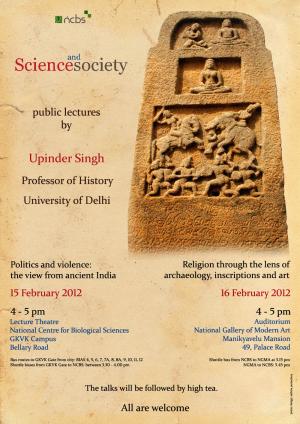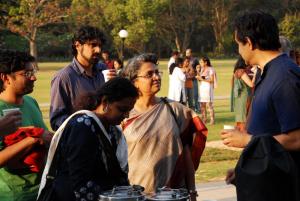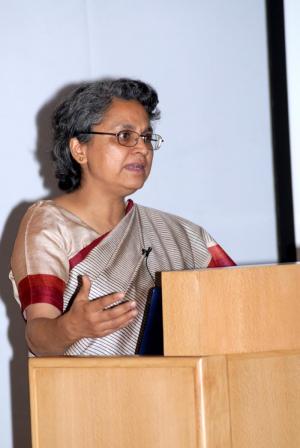Historian Upinder Singh talks about violence and religion in ancient India on her visit to NCBS
Upinder Singh, professor at the University of Delhi's Department of History, was at the National Centre for Biological Sciences (NCBS) on 15th February 2012 to talk about her ongoing studies of violence in ancient India. In a second talk on 16th February, hosted at Bangalore's National Gallery of Modern Art (NGMA), she focused on how ancient relics, inscriptions and sculptures deepen our understanding of religion in ancient India. Both talks were hosted by NCBS as part of the Science and Society program.
Singh's talk at NCBS examined the views on war and violence in three ancient Indian sources: the inscriptions of Asoka (the first emperor who unified most parts of the Indian subcontinent under his rule, in the late 3rd century BC), the ancient text of Nitisara (a book on political governance written by Kamandaka probably between the 4th and 6th centuries AD) and an epic poem Raghuvamsa (dated around c. 400 AD, which depicts the stories of the Raghu dynasty that the Hindu deity Rama is also considered to be part of), composed by the Sanskrit writer Kalidasa. Though we tend to think of a peaceful and idyllic anicent India, the truth seems to be far from it: violence was a frequent occurrence. But most interestingly, as Singh's talk revealed, scholars and kings thought a lot about violence and its role in administration.
At the NGMA, Singh focused on the insights that archaeological studies of inscriptions, art and other artefacts give into the religious aspects of life in ancient India. Archaeologists attempt to reconstruct past periods using a variety of sources. "You have to look for religion outside texts as well," Singh said. In 1927, 1938 and 1960, a number of archaeologists had excavated remains of Buddhist relics, sculptures of the Jataka tales (stories of the previous births of the Buddha) and inscriptions mentioning wealthy donors who funded their creation among others at Nagarjunakonda in Guntur district (Andhra Pradesh). According to Singh, they gave a more comprehensive view of ancient Buddhism than what old texts alone could have accomplished. "Monks also had fun," she said - excavations at the site had unearthed a gameboard inside a Buddhist monastery, replete with ivory dice.
The Science and Society program at NCBS 'funds and hosts projects and events that dovetail science and the humanities'. At NCBS Singh said it was the first time she had ever spoken to an audience of scientists, and for most of those there it was a novel experience to listen to a professional historian.



Comments
Post new comment